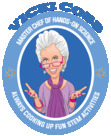Vicki Cobb's Blog, page 4
September 10, 2019
Get'em to Read Widely, Help 'em to Read Deeply
 What happens to behavior when living beings dwell in paradise? Where everything an individual could possible want is at hand? Plenty to eat and drink. It's not too hot, not too cold. Lethal danger is at a distance. I saw it for myself when I visited the Masai Mara in Kenya many years ago. Kenya is on the equator but the Masai plains of Kenya are elevated so the average temperature is 75 degrees every day. There are no seasons. Both night and day are 12 hours long. Nature provided this part of the world, enough space and food and water for the largest land-dwelling mammals to evolve. For elephants, hippos, water buffaloes, giraffes life exists in a serene landscape that is interrupted every so often with a scurry of activity when a predator gets hungry. But for the most part, it is a peaceable kingdom. Beasts wander through their day, not moving too fast, sleeping when they feel like it. A Kenyan professor told me that there is little or no incentive for the human population in this environment to become inventive or technological. People who live in the moderate latitudes were motivated to invent ways to make life more comfortable. That's why those places are the source for innovation and technology.
What happens to behavior when living beings dwell in paradise? Where everything an individual could possible want is at hand? Plenty to eat and drink. It's not too hot, not too cold. Lethal danger is at a distance. I saw it for myself when I visited the Masai Mara in Kenya many years ago. Kenya is on the equator but the Masai plains of Kenya are elevated so the average temperature is 75 degrees every day. There are no seasons. Both night and day are 12 hours long. Nature provided this part of the world, enough space and food and water for the largest land-dwelling mammals to evolve. For elephants, hippos, water buffaloes, giraffes life exists in a serene landscape that is interrupted every so often with a scurry of activity when a predator gets hungry. But for the most part, it is a peaceable kingdom. Beasts wander through their day, not moving too fast, sleeping when they feel like it. A Kenyan professor told me that there is little or no incentive for the human population in this environment to become inventive or technological. People who live in the moderate latitudes were motivated to invent ways to make life more comfortable. That's why those places are the source for innovation and technology.When I was young, I heard a lecture by Nicholas Negroponte, a futurist and co-founder of what is now the MIT Media Lab. He described a future where people would never have to leave their homes-- everything they needed could come to them with the push of a button. (It was before we knew about the click of a mouse). The only reason to leave home, he stated emphatically, would be to find a mate or get buried. Many skills by which people currently made a living would become obsolete. The picture he painted horrified me. But, I reasoned, people would still need to know how to read.

 That, too, is on the decline. Note the graph on the left. Except for the reading of cell phones, which is definitely on the upswing. Note the graph on the right. In 2017 the average adult spend 2 hours and 51 minutes per day on a mobile phone.
That, too, is on the decline. Note the graph on the left. Except for the reading of cell phones, which is definitely on the upswing. Note the graph on the right. In 2017 the average adult spend 2 hours and 51 minutes per day on a mobile phone.
Reading for pleasure, to fill up the day, has been pre-empted by a plethora of entertaining activities that require little else than watching. It seems as if the human race is devolving into doing the minimum to exist. As per Negroponte's prediction, we are getting fat and lazy. Negroponte went on to found a movement One Laptop per Child, hoping to reach all children including those who live in the third world. It failed for a variety of reasons, mainly because his manufactured product was poorly designed. In recent years, Negroponte has shifted focus and now says: "If you take any world problem, any issue on the planet, the solution to that problem certainly includes education. In education, the roadblock is the laptop."
I'm not sure that's true. I think that the problem in education stems from the lack of reading and thinking regardless of the device. Reading is the only way to get into the minds of educated people who know how to write well and think clearly. Learning to read takes practice. It should not be separated from thinking. That is why my tribe of award-winning authors of nonfiction for children have created the Nonfiction Minute. . We don't just write a readable essay, we also speak it aloud. This exposes less fluent readers the magic of content. The Minutes just happen to be the same length as the reading passages on the standardized tests. But each Minute is a self-contained essay with a beginning, a middle and an end not an excerpt from a larger work taken out of context for the test-taker to struggle with. Our Minutes are not leveled because leveling makes text flat and eliminates voice, the humanity that makes the content come alive. But the Nonfiction Minute is not enough to produce readers and thinkers. They need to tackle fuller works.
For this reason, iNK has opened a bookstore, iNK Books & Media Store . The categories that the books cover are illustrated above. Most of our books are interdisciplinary. They are also beautifully illustrated, carefully designed and edited to make them into learning experiences with the real world. We will be adding books all year. Pick a topic from the icons above that you're required to teach. Help your students discover the pleasure of learning from a good book. Let them build self esteem by doing something that requires effort and perseverance that is also a pleasure. Let them experience the work of people who have spent a lifetime thinking and perfecting their craft of putting words together to make meaning.
Otherwise, writers who think and care about educating children will also go the way of the typewriter manufacturers.
Published on September 10, 2019 06:32
September 2, 2019
Age of Anxiety
 Steve Clifford- Wikimedia Commons How many of us live in fear? And how many of those are children? The 24-hour news cycle doesn't help. The whole idea of terrorism is to create fear backed up, now and then, by some horrific random act of violence. As one great president noted upon entering WWII, "The only thing we have to fear is fear itself." That's because fear can be paralyzing and leave scars at a time when courage and perseverance are the only ways to prevail.
Steve Clifford- Wikimedia Commons How many of us live in fear? And how many of those are children? The 24-hour news cycle doesn't help. The whole idea of terrorism is to create fear backed up, now and then, by some horrific random act of violence. As one great president noted upon entering WWII, "The only thing we have to fear is fear itself." That's because fear can be paralyzing and leave scars at a time when courage and perseverance are the only ways to prevail.I'm particularly concerned with one kind of fear that seems to be permeating schools. It is associated with both learning and teaching. Children are afraid of failure, or to be more specific, not having the "right" answer. Teachers are afraid of straying from the prescribed curriculum into their own autonomy and personal experiences because they might miss "covering" something that shows up on the standardized test. As a result, their students will get the wrong answers and they will lose their job. So the bogey man that has a strangle-hold on schools, which should be safe places to fail, is the culture that has arisen around the high stakes attached to the standardized tests and the fear of testing. This is heightened by the time spent in test prep, the effect of a school's collective test scores on real estate values, and group-think shifting towards skill-and -drill, mind-numbing activities that may raise test scores at the expense of real learning.
Recently, I mentioned the upcoming Chappaqua Children's Book Festival to a nurse who I was drawing blood from me. She has two school-age children and I suggested she come to the festival. "But what if the books at the fair don't cover the questions on the test?"she asked. Now that's a really interesting question. It implies that a student must have some specific prior knowledge for the test and that schools have the secret sauce that will allow her children to succeed. Oy! Allow me to address this fear.
The Standardized Tests are basically reading comprehension. Questions pertain to passages that are excepted from books, including those written by iNK authors, not from texts books and other school books that are required reading. So the children who do well on the tests have read widely and deeply. Here are some suggestions to build up confidence in your own students and children:Begin with the Nonfiction Minute. Use the archives to find Minutes that appeal to your child. If your child is an English language learner or has reading challenges, have them listen to the audio file of the author reading his/her Minute, before attempting to read it themselves. This will strengthen the reading-for-meaning muscle.Go to the library with your student or child. Ask for books on subjects they are currently studying. Maybe they will recognize an author from the Nonfiction Minute. Have them read the first page to see if it interests them. Let them choose one book to read that they think that they will like. The aim is to leave the library with a book they are looking forward to reading.Keep it up. That's it. Reading widely and then deeply builds facility and confidence. Following interests builds knowledge bases that create a conceptual structure for each child that connects areas of interests. It brings out the uniqueness of individuals. Sometimes, it takes effort. That, too, has its rewards. All of these behaviors are strengthened with practice. Sometimes a little of the right kind of tutoring can be trans-formative.
As a child, I remember sharing my fears about school with my parents. They would suggest actions I could take to resolve my issues but mostly they told me I'd feel better the next morning. Amazing that they were right every time!
Published on September 02, 2019 05:52
August 18, 2019
A Primer for a Cultural Phenonmenon
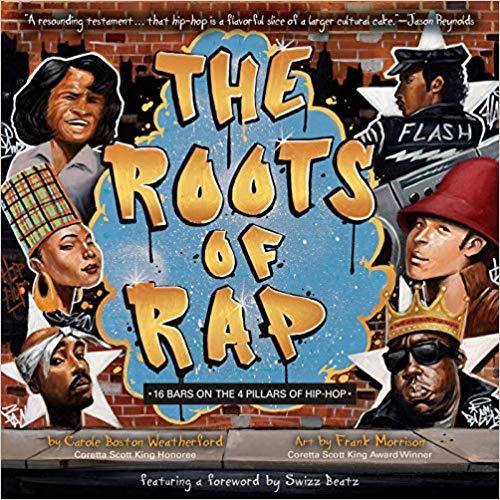 The more closely an individual skillfully expresses his or her own personal truth, the more it resonates with universal humanity. Thus, art is created. iNK author, Carole Boston Weatherford and artist Frank Morrison have created a work of art to explain an art genre-- the wildly pulsating manipulation of words, sounds, music, dance and rhythms of rap. Like other art forms, rap has its roots in earlier incarnations of popular music most of which are foreign to me. I was raised on classical music and discovered jazz as a young adult. I was never into popular commercial music as a girl although I did, on occasion, listen to the "Hit Parade" on the radio on Saturdays. I certainly didn't grow up with earbuds and unlimited access to what flows through fiber optic cables. So I'm not qualified as an expert to render my opinion on Weatherford's and Morrison's new book The Roots of Rap:16 Bars on the 4 Pillars of Hip-Hop. So, to do this work (which is clearly a labor of love) justice, I treated it as a study guide. I began by looking up the 4 pillars of Hip-Hop which are graffiti, break-dancing, rapping and "dub, " the simultaneous changes of speed and direction of two records on two turn-tables by one DJ.
The more closely an individual skillfully expresses his or her own personal truth, the more it resonates with universal humanity. Thus, art is created. iNK author, Carole Boston Weatherford and artist Frank Morrison have created a work of art to explain an art genre-- the wildly pulsating manipulation of words, sounds, music, dance and rhythms of rap. Like other art forms, rap has its roots in earlier incarnations of popular music most of which are foreign to me. I was raised on classical music and discovered jazz as a young adult. I was never into popular commercial music as a girl although I did, on occasion, listen to the "Hit Parade" on the radio on Saturdays. I certainly didn't grow up with earbuds and unlimited access to what flows through fiber optic cables. So I'm not qualified as an expert to render my opinion on Weatherford's and Morrison's new book The Roots of Rap:16 Bars on the 4 Pillars of Hip-Hop. So, to do this work (which is clearly a labor of love) justice, I treated it as a study guide. I began by looking up the 4 pillars of Hip-Hop which are graffiti, break-dancing, rapping and "dub, " the simultaneous changes of speed and direction of two records on two turn-tables by one DJ.First,I read the book through, soaking up the impassioned and powerful artwork of Frank Morrison. My take-away was that the source of the music was people rising up from urban streets who demanded that they be heard and created music and art (graffiti) that compelled attention. Although I had heard some of the names of the artists through the zeitgeist, I didn't really know who they were. So I went to You Tube, looked up the artist, opened a new window where I could read the lyrics as I listened to the music and watched the videos. I was determined not to miss a beat.
Weatherford introduces her musical history in The Roots of Rap with:
"Soulman James Brown shouting, 'I'm black and I'm proud.'
"Giving birth to funk--bass lining pulsing loud.
"BA BUMP BA BUMP BA BOOM BOOM BUZZ-- BA BUMP BA BUMP BA BOOM BOOM BUZZ"
This music was played at volume to the max in boom boxes and cars, filling public spaces with sound that invited dancing. Not just toe-tapping dancing but amazingly athletic break-dancing on sidewalks. I watched the B-Boys--the best of the best. Who know the human body was capable of such moves? Why haven't they been adopted to liven up the floor exercises in gymnastic competitions and add points for difficulty? Next came the Jamaican reggae beat that was embellished by DJs who man-handled turntables, improvising live and in real time a novel mix of already recorded music, creating a genre called "dub." D. J. Kool, known as the founder of hip-hop, interacted mightily with his live audience who kept up with his off-beat approach and rat-a-tat lyrics that are both fervent and witty. Weatherford was a kind guide to this greenhorn as she gently shared her knowledge of music that she has come to love. So if rap is foreign to you, this not just a book to read. It is a course in music appreciation.
In the back-matter there is a "Hip-Hop Who's Who" that can keep a playlist-builder busy. Rap has no limit in its range of expression, from anger to yearning to a celebration of life, which makes it popular world-wide. It is an amalgam of diverse cultures, beats, songs and poems. Some of it may be too raw for the very young. But then, some very young children have already experienced a harsh reality not of their own making. Whatever it is, there's a rap song for that.
In this one-of-a-kind picture book about music without a sound track Carole Boston Weatherford and Frank Morisson have created an introduction to a universal form of communication that is echoing around the world. Go catch the wave.
Published on August 18, 2019 10:52
August 10, 2019
Busy Chewing Up the Scenery to Make a New Environment for Others
 Meet an amazing animal that is doing its share to save the planet. It's a rodent-- the "dent" part of its name refers to its teeth, which it uses to gnaw down trees. So how does that help save the planet? The answer is in Dorothy Hinshaw Patent's latest book At Home with the Beaver: the Story of a Keystone Species. She tells the story with gusto and her text works seamlessly with Michael Runtz's photos that add clarity, close-ups and time-stopping images worthy of intense scrutiny.
Meet an amazing animal that is doing its share to save the planet. It's a rodent-- the "dent" part of its name refers to its teeth, which it uses to gnaw down trees. So how does that help save the planet? The answer is in Dorothy Hinshaw Patent's latest book At Home with the Beaver: the Story of a Keystone Species. She tells the story with gusto and her text works seamlessly with Michael Runtz's photos that add clarity, close-ups and time-stopping images worthy of intense scrutiny.The beaver must chew wood-- something hard-- to keep its ever-growing front teeth short. It uses its felled product to build. It alters the landscape with its dams that stop creeks effectively enough to form ponds that become a new environment for many other species of plants, fish, frogs, insects, birds. The pond becomes a food chain that would not exist but for the beaver. Since the beaver is the key to a new environment it is dubbed a "keystone" species. The original keystone is the wedge-shaped stone in the top center of a stone arch that keeps all the other stones in place, making the arch possible, even without mortar.
 This keystone is carved but it still makes the arch of this bridge stable and possible-Wikimedia commons
This keystone is carved but it still makes the arch of this bridge stable and possible-Wikimedia commons  The beaver's home is less asthetic but does the job. From At Home with the Beaver-Michael Runtz The web of life, the inter-dependency of species- is a complex concept that is crucial to our comprehension if we are going to make an effort to take care of our planet and the current seemingly distant threat of global warming. Patent's book shows the uninitiated how living creatures depend on each other and on the one species that creates a space for them to thrive.
The beaver's home is less asthetic but does the job. From At Home with the Beaver-Michael Runtz The web of life, the inter-dependency of species- is a complex concept that is crucial to our comprehension if we are going to make an effort to take care of our planet and the current seemingly distant threat of global warming. Patent's book shows the uninitiated how living creatures depend on each other and on the one species that creates a space for them to thrive.For those who love nature and have actually visited a beaver pond, this book is a way to introduce an amazing habitat to their friends. For those who have never visited a beaver pond, At Home with the Beaver can motivate them to put down their phones, and make plans to go find one for themselves.
Published on August 10, 2019 06:20
August 3, 2019
When Rules Get in the Way
 In the simplest terms, we Americans call ourselves a democracy that is "of the people, by the people and for the people." The act of voting establishes our power. So, just how well are we doing?
In the simplest terms, we Americans call ourselves a democracy that is "of the people, by the people and for the people." The act of voting establishes our power. So, just how well are we doing?In in 1787, after the colonies had won independence from the tyranny of Great Britain, they sent delegates to Philadelphia to "frame" the rules for the citizens of our new nation. The result is the Constitution of the United States of America-- a four page document with 4,591 words, including signatures. Over the years, another 3,048 words have been added in 27 Amendments. But according to Cynthia and Sandford Levinson, authors of 271 page book for the YA audience, Fault Lines in the Constitution: The Framers, Their Fights and the Flaws that Affect Us Today, following our Constitution as it is written has its problems. These are not unlike the work that a playwright has to do on a script after the actors start reading it. The questions about such texts are: What works and what doesn't?
For those who don't know much about the Constitution, it is defined by the Levinsons as "an agreement that describes how an organization is governed. It is different from a collections of laws. The purpose of a constitution is to determine who makes the laws, how those decision makers are chosen, how long they serve, and what powers they have......it is intended to help a group of people accept leadership and reduce friction. That's the idea at any rate."
Each chapter starts with an incident or event that conflicts with or has no obvious resolution within the Constitution as it is written. Outlining the problem and its resolution requires the attention of the reader. This is a challenge for its YA audience, and even for adult readers who think they know a thing or two (like me!). The Levinsons have broken down the problem into eight parts beginning with a Preamble (which means "walks before" and a Post-amble (backmatter, including a timeline, notes, etc.). It is a book to guide study in a course on civics. It should be digested bite by bite and be required reading for students who have ambitions for careers in public service in politics, law enforcement, and justice.
The Levinsons chose the words "Fault Lines" for their title because:
"The metaphor of fault lines come from geology and refers to shifting tectonic plates beneath the earth's surface that can cause rumbles ranging from mild vibrations to catastrophic earthquakes and tsunamis. Architects safe-guard residents in these zones by construction buildings that can withstand shaking.
"But what if you lived in a building that got a C on an earthquake safety test? Assuming you decided not to move, you'd want your home shored up. That's what we believe the Constitution needs--reinforcement. And it's up to all of us to provide it.."
The book ends with a debate between the authors (who are also husband and wife) who disagree on what we should do next. Both Levinsons do agree that the Constitution needs to be fixed. They each have ideas on how this is to be done.
Their conversation is a model for civil discussion that is supposed to take place on the floors of Congress as well as classrooms around our country.
The updated paperback revision of this book is available now.
Published on August 03, 2019 06:28
July 15, 2019
A Car for Vegans
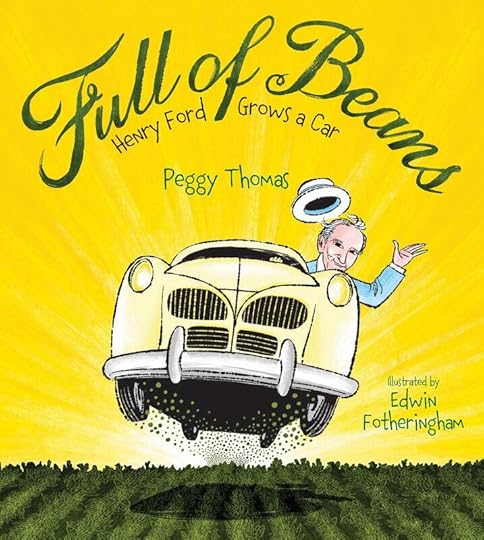 iNK Author, Peggy Thomas, has been fascinated with agriculture as an essential part of men who were not known for farming. These include George Washington and Thomas Jefferson. Now she has directed her attention to the great industrialist Henry Ford. In Full of Beans: Henry Ford Grows a Car, we meet Henry Ford as an inventive child searching for shrink-less wool, a motorized tractor, and a plant that could provide raw materials for industrial use in car manufacturing.
iNK Author, Peggy Thomas, has been fascinated with agriculture as an essential part of men who were not known for farming. These include George Washington and Thomas Jefferson. Now she has directed her attention to the great industrialist Henry Ford. In Full of Beans: Henry Ford Grows a Car, we meet Henry Ford as an inventive child searching for shrink-less wool, a motorized tractor, and a plant that could provide raw materials for industrial use in car manufacturing.In this light-hearted narrative, delightfully illustrated by Edwin Fotheringham, with floating cars and tipping his hats, Henry Ford is revealed as a man convinced that some plant or other could be farmed and transformed into material that could become raw materials for industry. He invested in building a laboratory surrounded by fields and found Robert Boyer, a chemist who recognized Ford's vision for vegetables. Voila! The soybean-- full of oil and protein, with the possibility that it could be cooked up into something useful for his automobile plants.
What could that be? I'm not going to be a spoiler and tell you the story-- read Full of Beans to be charmed, read it to discover how men of vision imagine what others can't see, read it to see how life interrupts the inventive process and that ultimately, it prevails.
The format of this books contains an entertaining story but the back matter enhances the story with information about Henry Ford as and inventor/ innovator and his impact on the agriculture of soybeans, turning it into the second most-grown group. There are hands-on activities in the back-matter so you can eat a cracker made from soy bean flour and create your own plastic from soy-bean oil.
I LOVE books like Full of Beans, because it is so interdisciplinary. Peggy Thomas has written a piece of literature for children that includes a narrative story about an amusing and eccentric character, a slice of history, and hands-on activities by examining an aspect of an man you probably never knew had his roots as a farmer.
Please plant Full of Beans: Henry Ford Grows a Card in your home or classroom library.
Release date: October 15, 2019
Published on July 15, 2019 05:47
June 17, 2019
Are You Interested in Working with Us?
 How would you sum up this past school year? First, we made it! At times it seems as if it was too, exhausting, too frustrating, too unfulfilling and way too endless. That's what I'm hearing from my teacher friends who are dedicated to their students, hamstrung by the standards, targets of parents and feeling very burnt out. Their eyes still light up when they recall special moments of rapport with their students.
How would you sum up this past school year? First, we made it! At times it seems as if it was too, exhausting, too frustrating, too unfulfilling and way too endless. That's what I'm hearing from my teacher friends who are dedicated to their students, hamstrung by the standards, targets of parents and feeling very burnt out. Their eyes still light up when they recall special moments of rapport with their students. iNK's mission is to give teachers something to teach that can brighten their day and remind them of why they became teachers. For us it was a very good year. Our numbers for the last month were off the charts. Almost 100,000 page views and our visitors to our site looked at an average number of more than 11 pages a visit. This past year, we were taken under the wing of one of the largest business consulting firms on the planet as a pro bono client. They got us off our rear ends and we've started a podcast. (My last post gave you the link.) We're designing a new website to debut in early September as the next school year rolls around. And more good news about us and our books on the horizon.
But we're worried about our teacher colleagues. The emphasis has shifted to concern about student grades than about student learning. At a time, when businesses say they need creators and innovators, classroom work is standardized with work sheets and flat, uninteresting written material. We hear from the trenches that teachers are frustrated at not being heard by the powers-that-be, are being held accountable for student performance in unfair ways, and have little autonomy in meeting curriculum standards. Many are burnt out, even in affluent schools where they stay because they can't afford to try something else.
How would you like to work with us and bring the joy of learning back to your classroom? iNK authors have written many books that fit into your school curriculum. We can start small, with a curriculum built around one of those books that fit into either grade 4 or grade 8 unit of study. iNK will supply classroom sets of books, work with your curriculum people and teachers to create professional development and teaching strategies that make teachers excited to teach, and help design projects for students with the input of the book's author that make students excited to learn. iNK is a nonprofit, as are schools. There is grant money around that can pay for this. We figure the cost of doing such a program for one unit is $2500 per school, for two-three classes and would include classroom sets of books, 2-3 hour of videoconferencing with the author-- some for PD for teachers and creating the curriculum, some for motivating students. We've done this and we KNOW it works. We're confident that even one unit reading a great book and creating a classroom project with the input of a real author is enough to make the standardized test scores go up.
The summer stretches before us. It will take work to get ready and get funding. If you're interested please contact me. It will make my day!
Published on June 17, 2019 12:37
May 21, 2019
Listen to Us!
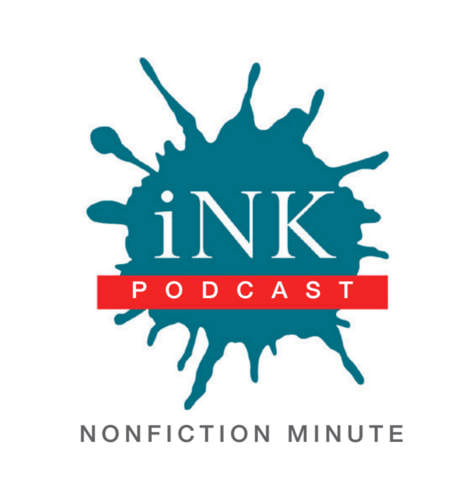 II'm an "early adapter" of technology. Years ago, when I first started making videos from my book We Dare You!, I posted a bunch of podcasts as videos in the iTunes store. Amazingly, when I check the stats today, my video podcasts have thousands of hits a month, more than any other page. I have never published the link to them but, what the heck, I 'll give it to you now. I published them through iTunes. They're called Vicki Cobb's Amazing Action Science If you look at the dates, you'll see that I uploaded them about ten years ago. You'll also know that they're in "kids & family" and the "lyrics" are listed as "clean."
II'm an "early adapter" of technology. Years ago, when I first started making videos from my book We Dare You!, I posted a bunch of podcasts as videos in the iTunes store. Amazingly, when I check the stats today, my video podcasts have thousands of hits a month, more than any other page. I have never published the link to them but, what the heck, I 'll give it to you now. I published them through iTunes. They're called Vicki Cobb's Amazing Action Science If you look at the dates, you'll see that I uploaded them about ten years ago. You'll also know that they're in "kids & family" and the "lyrics" are listed as "clean." This year, iNK was adopted as a pro bono client of one of the most prestigious business consulting firms on the planet. They looked at us as a young company who has established itself on the web with the Nonfiction Minute. Our stats, according to them, are amazing and organic. We average about 50,000-70,000 page views a month, even in the summer without any advertising or promotion. Their initial goal for us is to increase our presence on the web. To this end, we are redoing our website, which will debut at the beginning of the next school year. They also asked us to create podcasts from our audio files.
Young companies are nimble so we acted right away and started creating podcasts. They are free on the web for your listening pleasure. We are partnering with KidLit TV as one platform and we also have them available in the iTunes store. We have introduced them with a "soft" launch as we feel our way. Take a listen and let us know what you think.
Published on May 21, 2019 11:07
May 6, 2019
Surviving an American Shameful Act with Dignity and Resilience
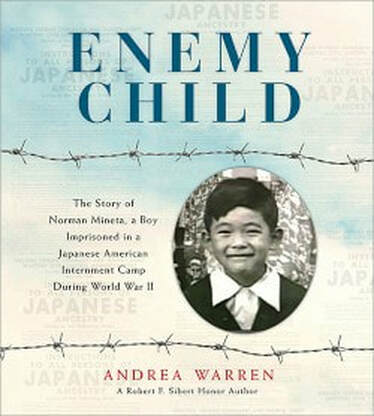 Award-winning iNK author, Andrea Warren writes American history as seen through the eyes of a child who is confronted with problems of historic proportions created by grown ups. Her latest book is
Enemy Child: the Story of Norman Mineta, A Boy Imprisoned in a Japanese American Internment Camp During World War II.
On December 7, 1941, the date President Roosevelt called "a day that will live in infamy," the Japanese allies of the Axis Powers bombed Pearl Harbor in Hawaii. Thus began American involvement in Word War II. Ten-year-old American boy, Norman Mineta, the youngest of five children, was suddenly confronted with hateful bullying at school. His classmates accused him of perpetrating this dastardly act because he looked like the enemy.
Award-winning iNK author, Andrea Warren writes American history as seen through the eyes of a child who is confronted with problems of historic proportions created by grown ups. Her latest book is
Enemy Child: the Story of Norman Mineta, A Boy Imprisoned in a Japanese American Internment Camp During World War II.
On December 7, 1941, the date President Roosevelt called "a day that will live in infamy," the Japanese allies of the Axis Powers bombed Pearl Harbor in Hawaii. Thus began American involvement in Word War II. Ten-year-old American boy, Norman Mineta, the youngest of five children, was suddenly confronted with hateful bullying at school. His classmates accused him of perpetrating this dastardly act because he looked like the enemy.At first, Norm thought nothing would happen to his family because the Constitution says "No person shall be deprived of life, liberty, or property without due process of law." But gradually the discriminatory rhetoric and behavior towards Japanese Americans escalated, quickly culminating in Executive Order 9066 by President Roosevelt that led to the interment of 120,000 West Coast Japanese Americans, without a scintilla of "due process." The rationale, born of fear, was to make certain that they would not "collude" with the country of their ancestry. Warren is brilliant in interweaving this history with its impact on a boy who loved baseball and cub scouts and his family of seven, as they were ripped from their comfortable home in San Jose and herded on to long trains with covered windows. Their journey took them first to a single barrack's room in the middle of the Santa Anita Race Track until they could be dispatched to permanent barrack accommodations behind barbed wire and armed watch towers in the shadow Heart Mountain, Wyoming-- an austere, isolated landscape of high winds, frigid winters and baking summers. It was three years before they returned home to San Jose.
Norman Mineta survived, and in some ways thrived, during this unjust, punitive period, never losing his love for America. When he grew up, he ran for elected offices, first becoming the mayor of San Jose, then a congressman for 20 years. When he retired from congress he was a cabinet member for both Bill Clinton and George W. Bush. Through the Boy Scouts, Norm had made friends with Alan Simpson of Cody,Wyoming, during joint scouting activity at the internment camp. Years later they reconnected when Mineta was in the House of Representatives and Simpson was a Senator. Their friendship was renewed and together they worked to pass the Civil Liberties Act into law, 43 years after the war had ended. In it, America apologized to for the internment of Japanese American community and paid a reparation of $20,000 to each living survivor.
Enemy Child is an initiation into a dark period of American History. As a book for young adults, Warren assumes little or no prior knowledge of these events from the reader. Thus, as the story of Norman Mineta unfolds, so does its historical background. It is a powerful, poignant page-turning narrative of an American boy who was treated as a prisoner and reviled as an enemy because of his ancestry. But it is also a story of patriotism, honor, dignity and resilience from a family of immigrants who never, for one second, was disloyal to our country.
This book is not just for young Americans but for all of us. It's another important reason for adults to mine the great literature that awaits in the children's room of the library.
Published on May 06, 2019 07:12
April 24, 2019
Million $ Jeopardy Winner Credits Children's Books
 There's a lot of buzz about the latest record-breaking Jeopardy winner, James Holzhauer, who became the second contestant in the history of the game to win more than a million dollars. Yes, he has a strategy on how to win BIG. He goes for the high money clues-- the hardest hints-- because he has a real body of knowledge he can literally count on.
There's a lot of buzz about the latest record-breaking Jeopardy winner, James Holzhauer, who became the second contestant in the history of the game to win more than a million dollars. Yes, he has a strategy on how to win BIG. He goes for the high money clues-- the hardest hints-- because he has a real body of knowledge he can literally count on. I am not a die-hard Jeopardy fan, but I've watched it a few times. How could I not? It's part of American lexicon. And I was pleased that I knew a few of the answers. ( Yet, I couldn't twist my brain around to phrase the answer as a question.) But the statement that caught my eye in the NY Times article of April 23, 2019 , is Holzhauer's attribution about where his knowledge comes from:
"As for the sources of his knowledge, Holzhauer has said that an underrated strategy is reading children’s books, which he said are more effective than adult books because they cater to readers who might not be naturally interested in the subject matter."
I am presuming that he is referring to children's nonfiction because he is mentioning "subject matter," i.e. "content." He is not referring to "textbooks" or school books or even school. He's a reader who long ago discovered what we, who write children's nonfiction, hope that the education community and maybe even the patrons of school and public libraries would also discover. If you want to learn about something new, read a kid's book or two on the subject. You'll soon learn who the best nonfiction authors are. They are the ones who treat the reader as an intelligent person (not using over-simplified language or "dumbing down" a subject) but assume that their reader has little or no prior knowledge on the subject. We write for the uninitiated on content that captivates us as authors so that our writing will also captivate our readers. We use a lot of the techniques of the best fiction authors and have invented a few tricks of our own.
A study in 1988 showed that good writing is memorable. That concept has paid off very well for James Holzhauer. Maybe those who marvel at the depth of his knowledge will be inspired to follow Holzhauer's course of study. He read for pleasure about the real world, he followed his interests when he read, and he studied Jeopardy from childhood to master the moves of the game. He learned that he could play the game and play it well before he became a contestant.
I'm betting that he's still reading children's nonfiction.
Published on April 24, 2019 08:02

